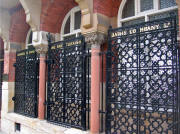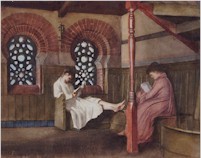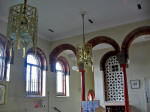 This distinguished and long-lived swimming club is owned and run for its members by the Drumsheugh Baths Club Limited. It was opened just after Christmas 1884 by the Drumsheugh Swimming and Turkish Baths Company Limited which was originally incorporated two years earlier in 1882. The club's original object was to establish swimming and Turkish baths in Edinburgh, though the Turkish baths no longer exist.
This distinguished and long-lived swimming club is owned and run for its members by the Drumsheugh Baths Club Limited. It was opened just after Christmas 1884 by the Drumsheugh Swimming and Turkish Baths Company Limited which was originally incorporated two years earlier in 1882. The club's original object was to establish swimming and Turkish baths in Edinburgh, though the Turkish baths no longer exist.
A prospectus for the company was issued in March 1882. The company was to have a capital of £12,000 to be issued as 2,400 shares of £5 each. The site, on steeply sloping ground was stated to have cost £2,500 and it was estimated that a further £8,500 would be needed to cover the erection and furnishing of the baths. 11
The company commissioned Sir John James Burnet (1857-1938) to design a building in 'saracenic' style to be erected in Old Queensferry Road (now Belford Road) in Dean Village. However, nowhere near the expected capital was raised, and the plans were cut back so as to omit the club rooms which had been planned for a fourth storey.15
 'Externally' wrote
The Scotsman,12 'the building is of little architectural account—its only characteristic features being a series of Turkish lantern ventilators; but the interior is unique in its way—a certain Oriental feeling pervading all its parts.'
'Externally' wrote
The Scotsman,12 'the building is of little architectural account—its only characteristic features being a series of Turkish lantern ventilators; but the interior is unique in its way—a certain Oriental feeling pervading all its parts.'
The main part of the building was a large hall occupied by the swimming pool. Galleries overlooking the pool led on one side to a gymnasium and on the other to the Turkish baths suite with its dressing rooms. The front of the latter gallery comprised glazed gilded lattice-work screens through which the swimmers could be watched.
The Turkish baths comprised four rooms leading off each other: the cooling-room, 40ft by 50ft; the tepidarium, 36ft by 21 ft; the outer hot room, 20ft by 12ft; and a crescent-shaped inner hot room, 18ft by 12 ft.
The cooling-room and tepidarium are divided by a Turkish arch, with large glass centre; and between them is a plunge bath, 22 ft in length, 6ft 3in across, and 6ft in depth. An Oriental screen separates the tepidarium from the outer calidarium, and rich hangings cover the entrance to the inner chamber. Off the tepidarium is the shampooing-room, with marble seats and spray and shower baths. The heating of the Turkish baths is by steam coils.
It was intended to maintain the two hot rooms at 200 and 220 degrees Fahrenheit, though it is impossible to tell whether these temperatures were actually achieved. In addition there was also a Russian steam bath. After dark, the rooms were lit by antique Turkish lamps.
The club opened on Friday 26 December 1884 with Mr William Cameron as its manager. Women were able to use the baths on part of each of three days in the week, while men used them for the rest of the week.
After its first six months, the club membership included 423 senior gentlemen, 223 junior gentlemen and 369 ladies, and twelve families (representing at least another 50 persons). The club earned £1,904.19s.0. from fees, 'entry money' and swimming lessons, while its expenditure was estimated at £1150, showing a suggested surplus equal to 4% on the subscribed share capital.15
The prestigious Club's premises were praised in 1988 in John Sweetman's book on Islamic influences on British and American art and architecture. He wrote that ' its arched main interior remains the most impressive "Saracenic" example in Scotland' adding, in a footnote, that 'Burnet's Edinburgh Baths still exist, though some features are now missing.' 4
In 1995, Danby Miles, in his book Moorish style, praised the elegance and sensitivity of the building which 'the original club continues to occupy'.5
Neither writer seemed to realise, however, that the building which they were praising is not Burnet's original building, but a later copy of it. For the original building was completely destroyed by fire on the night of Saturday 6 February 1892. The flames spread to a mission hall immediately behind the baths and to the studios of the sculptor, D W Stevenson, which were severely damaged by both fire and water.6
Burnet's company, Burnet, Son & Campbell, was responsible for reconstructing the baths on the original site at an estimated cost of £6,000. The Moorish style building was to be (as the journal Building news laconically put it) 'Similar in almost every respect to the old one, but fireproof.' 7
We don't at present know how long it took to rebuild and reopen the club, but the fire clearly explains Sweetman's footnote that 'some features are now missing.' The rebuilt Turkish baths suite was, in fact, not as large as the original, the main difference being that there were only two hot rooms instead of the original three which originally complemented the cooling-room.
 None of this, of course, in any way detracts from the elegance and stylishness of the replacement building with its façade broken by 'horseshoe arched windows shuttered with Moorish metal grilles bearing the title "Drumsheugh Swimming and Turkish Baths Company LD".' 10 How many architects must secretly yearn to have a second chance to rebuild an earlier design and take advantage of the experience gained during the construction of the original.
None of this, of course, in any way detracts from the elegance and stylishness of the replacement building with its façade broken by 'horseshoe arched windows shuttered with Moorish metal grilles bearing the title "Drumsheugh Swimming and Turkish Baths Company LD".' 10 How many architects must secretly yearn to have a second chance to rebuild an earlier design and take advantage of the experience gained during the construction of the original.
 The Turkish baths suite on the second floor now comprised a cooling-room, two hot rooms, plunge pool and dressing room.8 It was built in brick and stone, with plain blue-green glazed tiles in the hot rooms, and a domed cooling-room.9 As with most of the Scottish Turkish baths, provision continued to be made for the baths to be used by women at certain times during the week.
The Turkish baths suite on the second floor now comprised a cooling-room, two hot rooms, plunge pool and dressing room.8 It was built in brick and stone, with plain blue-green glazed tiles in the hot rooms, and a domed cooling-room.9 As with most of the Scottish Turkish baths, provision continued to be made for the baths to be used by women at certain times during the week.
Shortly after the baths were reconstructed the financial strain proved too much for the company and it went into liquidation. A new company, the Drumsheugh Baths Club Limited, was formed and was able to acquire the building, together with all fixtures and fittings, from the liquidator for £4,500.16
The suggestion made in Building news (quoted above) that the rebuilt baths were fireproof proved to be incorrect when the building again caught fire on the afternoon of 17 June 1920. This time, however, the fire was less serious and the Fire Brigade soon had the blaze under control. Not, however, before the roof of the Turkish baths had been partially destroyed.13
During the second world war, the club played its part in the war effort by inviting 'all Officers of H.M. Forces and all ranks Women's Services (if wearing uniform) to the Swimming, Shower, Plunge, Turkish and Russian Baths, on special guest terms.'14 We can only assume that they were allowed to remove their uniforms once inside!
 Some time in the 1950s,10 the Turkish baths were discontinued and the area began to be used as a rather basic gymnasium. A new timber floor, more appropriate for a gym, was installed, probably in 1977. The Victorian swimming pool (with rings and a trapeze over the water), is still 'lit by cupolas in an open timbered roof and a tall arched window', the roof being 'supported by Moorish arches on slender cast-iron columns'.10 Other facilities currently available to members include a sauna and bar.
Some time in the 1950s,10 the Turkish baths were discontinued and the area began to be used as a rather basic gymnasium. A new timber floor, more appropriate for a gym, was installed, probably in 1977. The Victorian swimming pool (with rings and a trapeze over the water), is still 'lit by cupolas in an open timbered roof and a tall arched window', the roof being 'supported by Moorish arches on slender cast-iron columns'.10 Other facilities currently available to members include a sauna and bar.
There are still some gaps in our current knowledge of the history of the Turkish baths which were formerly part of the facilities of the Drumsheugh Baths Club, and further research is still needed.
